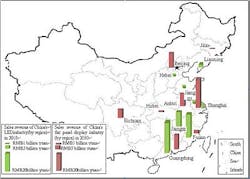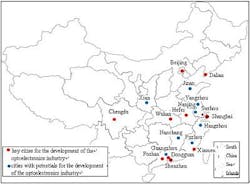Beijing, China--In October 2010, Chinaâs State Council officially recognized the optoelectronics industry as one of the countryâs emerging industries of strategic importance, including reference to sub-industries such as displays and LEDs. In 2011, the starting year of Chinaâs 12th Five-Year Plan, CCID Consulting launched its China Optoelectronics Industry Layout White Paper to facilitate the country's central and local governments in their layout planning of the industry, based on CCID Consultingâs analysis of China's optoelectronics industry (with an emphasis on the LCD and LED sectors) covering the aspects of layout, industrial characteristics and route of relocation, and its forecasts on the industryâs future trends.
As the layout of China's optoelectronics industry by output value in 2010 indicates, the flat display sector features four clusters in the Bohai Rim, the Yangtze River Delta, the Pearl River Delta, and midwestern China, while the LED features three key areas in the Bohai Rim, the Yangtze River Delta, and the Pearl River Delta.
The major cities of the Bohai Rim optoelectronics cluster, namely Beijing, Tianjin, Dalian, and Jinan, are supporting the industryâs development and upgrade with their scientific and research capabilities.
The Yangtze River Delta contains Chinaâs largest optoelectronics cluster and leads in R&D, manufacturing, and application. Chinaâs biggest LCD module bases are located in the Yangtze River Delta cities of Suzhou, Shanghai, and Nanjing. It is also among Chinaâs first batch of regions where the LED industry sees a debut, and currently holds two state-level semiconductor lighting bases in Shanghai and Yangzhou.
The Pearl River Delta is an important production base of complete electronic sets in China, especially LED products. It is also Chinaâs biggest LED packaging base, with Guangdong Provinceâs output accounting for around 70% of the national total and 50% of the world total.
Boosted by favorable governmental policies, cities in midwestern Chinaâincluding Nanchang, Hefei, Wuhan, and Chengduâhave been qualified for taking over the electronic manufacturing capacities from the Yangtze River Delta and the Pearl River Delta.
Due to the resource shortage in the eastern coastal areas and the guidance of the national policies, Chinaâs optoelectronics industry is seeing an accelerating relocation westward, forming the Central Belt ranging from Chengdu in the west to Hefei in the east and the Eastern Belt ranging from Dalian
in the north to Zhuhai in the south.
As the global electronic information capacities continue to relocate to regions with lower cost and closer to the emerging market and as the optoelectronics industry is on a fast track of rising, the relocation of optoelectronics capacities is of higher efficiency and quality. With the absorption of
relocated capacities from abroad, the size of Chinaâs optoelectronics industry continues to expand, while the industrial structure is expected to be optimized.
The optoelectronics industry requires a large amount of fund, land, and power resources, as well as policy supports. Due to a re-configuration of the resources, Chinaâs optoelectronics industry is seeing a relocation from the coastal areas to the inland areas. The well-developed inland cities with abundant supporting facilities will take the lead to take over the relocated optoelectronics capacities. As the optoelectronics industry in these cities continues to grow and exert an increasing influence on the periphery industries, the layout of Chinaâs will experience a great leap.
As the optoelectronics industry features high technical and capital investment, Chinaâs local governments have been playing a significant role in the allocation of fund and land resources and policy supports, especially at the early stage of the industryâs development. Therefore, the local governments that are determined to develop the optoelectronics industry will help consolidate the industry in certain areas of China.
In the process of the industrial consolidation, different regions will focus on different areas of the industry under the stateâs guidance to ultimately achieve a highly scientific and efficient layout.
-----
Follow us on Twitter
Follow OptoIQ on your iPhone; download the free app here.
Subscribe now to Laser Focus World magazine; it's free!

